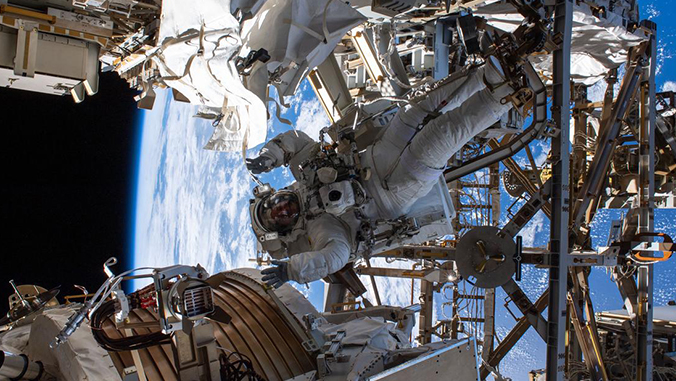
The Alpha Magnetic Spectrometer (AMS-02) experiment aboard the International Space Station (ISS), worked on by two University of Hawaiʻi at Mānoa physics professors Veronica Bindi and Philip von Doetinchem, is undergoing repairs.
Since May 2011, AMS-02 is operating as an external module on the ISS and is essentially a full particle physics detector shrunk to the size of the Space Shuttle payload bay. The experiment had been operating very successfully until recently when four pumps of the AMS-02 cooling system failed. Repair is needed to extend the lifetime of the experiment. This is especially crucial to the study long-term variation of cosmic rays and the search for the rarest particles, which are the focus of Bindi and von Doetinchem’s research.
Four Extravehicular Activities (EVA) are planned in order to install a new cooling system for the instrument. The current EVA series are considered the most challenging spacewalks since the repair of the Hubble Space Telescope in 2009, mainly because AMS-02 was not designed to be serviced. The repair effort required the development of special tools to gain access to the instrument and its cooling system while minimizing the creation of debris or sharp edges that could put astronauts at risk. Astronauts Andrew Morgan and Luca Parmitano trained extensively on those tools and techniques prior to flying to the ISS and are in charge of these EVAs.
The first spacewalk, which took place on November 15, set up the worksite for the repairs, including removing a debris cover to gain access to the instrument. During the second spacewalk on November 22, the astronauts cut the tubes of the old cooling system to prepare for the installation of the new pump system. The third spacewalk is expected on December 2 at 2:10 a.m. HST and can be followed live. Scheduling of the last spacewalk will depend in part on the progress made during the first three, as well as other station activities. Studying the abundances of different types of cosmic rays, the goals of the AMS-02 experiment are very broad from understanding highly energetic acceleration mechanisms in the galaxy and the galactic environment to examining solar effects to trying to understand dark matter and the asymmetry of matter and antimatter.
More on Bindi and von Doetinchem
Bindi has been part of the team that constructed, integrated and operated the Alpha Magnetic Spectrometer for more than 17 years. Since 2012, Bindi has been an associate professor in the UH Mānoa physics department. Her group, composed of post docs, research assistants, and several undergraduate students, is involved full time in the data analysis of the AMS-02 instrument. She extended the goals of AMS-02 to studying the solar modulation of cosmic rays, solar energetic particles, and space radiation. She is the principal investigator of a long-term grant with NASA to use AMS-02 to study the space radiation environment for future manned missions to the moon and Mars.
Commenting on the ongoing repairs Bindi said, “From Wallops NASA facility, I observed the rocket launch on November 2nd that successfully brought AMS-02’s new pump system and tools to the International Space Station with extreme excitement. I followed from the control center in NASA headquarters, all the steps that the Italian astronaut Parmitano performed during the two interventions on AMS-02. Now we still have at least two more EVAs to go, and they are the most complicated ones. I really hope that the AMS-02 repair will bring new life to the instrument and that we can extend the data taking for many years to come. These data provide crucial information on space weather and space radiation environment necessary for future space manned missions.”
Von Doetinchem is a long-term member of AMS-02 and contributed to construction, integration, operation and analysis since he was a graduate student. His research group focuses on searching for the extremely rare antiparticles, which are potentially playing an important role in discovering the nature of the unknown dark matter. Researchers know that dark matter makes up a very large fraction of the universe, in-fact much larger than the known luminous matter, and unveiling its properties is one of the towering questions in physics.
“I am very excited about the ongoing repairs. Knowing how challenging the integration of the payload was on the ground, I can only imagine how difficult it must be in space. Extending the lifetime of the experiment is very important for my research and will hopefully help to shed light on dark matter,” he said.

